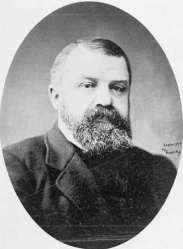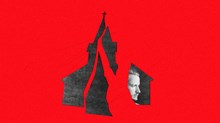
A few days after Christmas I caught up with some news stories about the sale of the boarding schools evangelist Dwight L. Moody founded for poor children in 1879 (the Northfield Seminary for Young Ladies) and 1881 (the Mount Hermon School for Boys). Hat tip to Philadelphia journalist W. G. Shuster for the links.
The basic facts according to news reports:
- The Massachusetts schools had gone co-ed in 1971, consolidated on one campus in 2005, and needed to find an appropriate owner for the unused and deteriorating Northfield Campus.
- Hobby Lobby, a privately held retail chain with a Christian vision, purchased the property for a nominal $100,000 and a commitment to preserve the historic campus and building. They are planning to spend about $5 million in operations and capital improvement projects over the next few years.
- Hobby Lobby then donated the property to the C. S. Lewis Foundation, which since its founding in 1986 has been looking for a way to start a great books college based on a Christian educational vision.
- The C. S. Lewis Foundation (which earlier purchased and refurbished Lewis's Oxford home known as "The Kilns" and holds periodic seminars there) plans to launch C. S. Lewis College on the Northfield campus in 2012 with an initial entering class of 400, a faculty of 40, and a staff of 45.
So what is the story behind the schools Dwight L. Moody founded and the campus that will soon take the name of C. S. Lewis?
As someone with only a rudimentary education, Moody quickly learned the value of practical learning. He was not interested in educational theory or systems. He was interested in equipping people who did not ordinarily have access to education—women, the poor, ethnic minorities. And with his passion for evangelism, he saw that with a little education, they could reach others with the gospel that the seminary-trained preachers never could.
In Moody's day, there was a lot of progressive educational theory in the air. The ideas of the American John Dewey and the Europeans Herbart, Pestalozzi, and Froebel permeated the air, wrote Virginia Lieson Brereton in Issue 25 of Christian History. Although he was not interested in ideas, Moody no doubt picked up the eagerness for experimentation and the passion to connect education to real life, to motivate students, and gear the content of learning to student understanding.
Rather than studying theory, Brereton reports, Moody studied the experiements of others in England and Europe: the deaconess institute at Mildmay, Charles Spurgeon's London college for poor and ill-educated Baptist pastors, George Müller's orphanage-school at Bristol, and H. Grattan Guinness's East London Institute for Home and Foreign Missions.
After reading the news accounts of the purchase of the Northfield campus, I called Moody Bible Institute historical theologian Gregg Quiggle for some perspective. I met Professor Quiggle in October, when he read a précis of his dissertation-in-process to a group of visiting scholars. His dissertation examines Dwight Moody's social vision and contradicts David Moberg's claim in The Great Reversal that Moody bears a major responsibility for evangelicalism's abandonment of its 19th-century commitment to social justice.
I asked Professor Quiggle what the significance of the Northfield Mount Hermon School was in the ministry and legacy of Dwight Moody. Without a moment's hesitation, he fired off these six bullet points:
- The Northfield Seminary for Young Ladies was Moody's initial foray into education. It is significant that Moody's first school was for women. It shows his commitment to the role that lay women could play in Christian ministry.
- A Bible institute developed there later that was a forerunner of Moody Bible Institute. The school was Moody's initial foray into Bible institute-style education (as opposed to providing a general education from a Christian perspective).
- The Mount Hermon School for Boys is where Moody began educating young men. It developed after the Northfield school, but both schools were intentional in their commitment to poor children of any ethnicity. These schools reflect Moody's commitment to the poor and to diversity in gender and race. In fact, Quiggle wrote in a follow-up e-mail, "Moody actively recruited Native American and African American girls for the first class at Northfield. He actually sent a woman out to the reservations to find Native American girls who could benefit from the education and would go back to their people to teach. That is what Northfield was about. He also insisted Bibles be placed in the foundation of the buildings at Northfield. That is also what it was about."
- The Northfield campus is also the site of the Northfield Bible conferences (which began in 1880). These became significant for evangelicalism generally as a rallying point where significant evangelicals from both sides of the Atlantic came to speak. These meetings cemented the links between British and American evangelicalism that had begun in the colonial period with transatlantic preachers like George Whitefield and John Wesley. That Anglo-American evangelical connection continued its influence down through the 20th century, symbolized for example by the cooperation of John R. W. Stott and Billy Graham in the Lausanne Congress for World Evangelization.
- Mount Hermon was also the site of the beginnings of the Student Volunteer Movement. At the Northfield Conference (July 1886), 251 students met to study and pray for nearly a month, and from their fervor developed a movement that supplied much of the energy for the unfolding missions movement of the late 19th and early 20th centuries.
- The sale of the Northfield campus to the theologically orthodox C. S. Lewis foundation is full of irony. After the days of Dwight Moody, the Mount Hermon and Northfield schools came under the influence of liberal Christianity, whereas Chicago's Moody Bible Institute became a point institution by fundamentalism. This divergence reflects the trajectory of the two major strands of North American Protestantism. But that divergence also reflects the broad tolerance of Dwight Moody. He disagreed with the modernists' approach to Scripture, but as long as they were people of faith and integrity and spoke positively about Jesus, he appreciated the devotionalism of the early modernists and welcomed them to his conferences. Thus modernists and proto-modernists like Henry Drummond, George Adam Smith, Washington Gladden, and Harry Sloane Coffin were invited to preach alongside R. A. Torrey, C. I. Scofield, F. B. Meyer, A. A. Bonar, Hudson Taylor, G. Campbell Morgan, and A. J. Gordon. That list reflects not only the modernist-fundamentalist spectrum, but also the transatlantic nature of his network.
How appropriate then that the new educational institution to inhabit the premises will be named after and built on the ethos of the UK's pre-eminent Christian apologist of the 20th century. Best wishes to Stan Mattson and the folk at the C. S. Lewis Foundation as they launch this new Christian college.
Links for further reading:
News articles about the sale of the Northfield campus in the Daily Hampshire Gazette (requires subscription) and The School Library Journal
Virginia Lieson Brereton's article on the Northfield Schools from Christian History issue 25 (requires subscription)
The history page at the Northfield Mount Hermon School website
Website of C. S. Lewis College
Press Release about Hobby Lobby's purchase of the Northfield campus
Photo of Dwight Lyman Moody circa 1900 from the U.S. Library of Congress Prints and Photographs Division under the digital ID cph.3c22752 via Wikimedia Commons.

Support Our Work
Subscribe to CT for less than $4.25/month




























